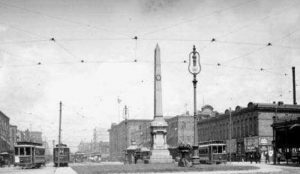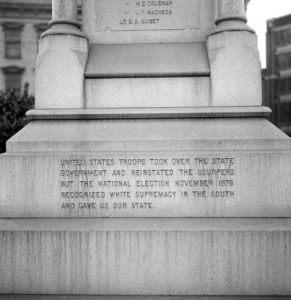Echoes of the Reconstruction Era: October 2020
ECW welcomes back Patrick Young, author of The Reconstruction Era blog.

The White League was one of the largest and most dangerous of the Reconstruction Era militias. It embraced the worldview of the Ku Klux Klan, without the funny robes and hoods. The White League is mentioned in reports of violence and intimidation against African Americans in Louisiana as early as March of 1874, but its commander, former Confederate Colonel Fred Ogden, said that it was founded on July 1, 1874. That was the date of the group’s first convention. I have been researching this important organization and you can find links to the primary sources I used throughout this article.
According to the League’s founding document, the principal problem of Reconstruction was that “the right of suffrage was given to the negroes too hastily.” According to the League’s platform, African Americans were trying to “drive the white man from this state and convert Louisiana into a second Hayti.” The White League called for “the white men of Louisiana to unite in defense of their families and civilization.” It called African American government officials inherently and universally “unfit” for the offices that they held “no title” to their positions “other than the color of their skins.” The platform also denounced the “increasing arrogance” of the African American populations. The League pledged to defend “our hereditary civilization and Christianity menaced by a stupid Africanization…” The League called “to the men of our race…to unite with us against that supreme danger.” The platform proclaimed that for the “common good of both races,” white men must unite “to re-establish a white man’s government in the city and the State.”
The White League controlled several media sources, which allowed them to communicate with potential supporters. One outlet for the group’s propaganda was the Opelousas Courier newspaper which proudly announced that on May 25, 1874 “the control of the editorial column of the Courier passes into the hands of the White League.” The newspaper included a parody on Hamlet’s Soliloquy that began “Social equality, or no social equality. That is the question./Whether ‘tis nobler in the mind to suffer/The impudence of every nigger and petty office holder/or to take up arms against a sea of carpet-baggers and scalawags,/ and by opposing, end them.”
In August 1874, the White League was accused of carrying out killings and attacks in Louisiana and other states. One “outrage” that attracted national coverage was the murder of a seventeen-year-old mixed-race teacher at a school for African American children. Julia Hayden had just begun her career as a teacher in rural Tennessee a few weeks before her death. While the African American community decried the murder as part of a broad White League attack on education for the children of former slaves, defenders of the League argued that the two white men involved in her killing had merely wanted to rape her and had shot her when their designs had been frustrated. The Coushatta Massacre in the rural Red River Louisiana parish of that name was a direct attack on African American political participation. Carried out in late August, at least 200 White Leaguers mobilized to kill as many as two dozen African Americans and white Republicans.
While the White League constantly played up the threat of an African American uprising in Louisiana, it was the White League itself that was actually plotting an armed overthrow of the government. Stories began to appear in the press of mysterious arms shipments arriving in New Orleans. On September 12, 1874, for example, the New York Herald reported that 288 weapons intended for the White League had been seized on the docks of the city. The League was also active in recruiting men from outside its core native-born, English-speaking demographic. On September 10, a newspaper account appeared describing White League recruitment in the Italian immigrant community. The League was already active in recruiting French-speaking whites as well as Irish immigrants, two groups that had resisted joining that earlier manifestation of white power, the Ku Klux Klan.
On September 14, 1874, the White League’s coup finally took place. Reports say that 5,000-8,000 armed White leaguers assembled in New Orleans at the Henry Clay statue and fought what is now called the Battle of Liberty Place. Organized League military companies seized strategic points, commanders posted snipers on the roofs of tall buildings, and masses of armed men assaulted the municipal police and a mostly African American militia led by Confederate veteran General James Longstreet. The uprising was called to depose Republican governor William Kellogg and install William McEnery in his place. McEnery and Kellogg had fought for the governorship in the 1872 election and each had charged the other with fraud, but Kellogg took the office. The League captured city hall and other government buildings and was briefly in control of the centers of government. Federal troops were called in to restore order.

The life of an everyday foot soldier of the White League is the subject of a new book by Edward Ball, the author of the National Book Award-winning Slaves in the Family. The book, Life of a Klansman, recounts the story of a Confederate veteran’s involvement in post-war white supremacist terrorist groups and militias. You can read my thoughts on Ball’s volume here.
During the heyday of Confederate monument building, a memorial to the “martyrs” of Liberty Place was erected in 1891. The cornerstone ceremony was held on September 14, the anniversary of the coup, and the Louisiana state militia, the descendant of the White League’s militia companies, was prominent at the ceremony. A newspaper headlined that the day witnessed “A Grand Outpouring of the People to Do Honor to the Heroic Dead.” Of course, the only “Heroic Dead” honored were the White Leaguers. Murdered African Americans defending the city were unmourned in this civic spectacle.
Most years thereafter solemn ceremonies were held at the monument, often organized by the United Daughters of the Confederacy (UDC). The Daughters saw the 1874 coup as a continuation of the Confederate project and the women’s group celebrated the heritage of the White league.

On September 11, 1932, the New Orleans Times-Picayune announced in a headline that the city was committed to preserving the Liberty Place monument. In big type, the headline read: “Memory of Those Who Fought for White Supremacy to Be Kept Green.” That year a new inscription was added to the monument to ensure that its history was accurately interpreted. It read: “McEnery and Penn having been elected governor and lieutenant-governor by the white people, were duly installed by this overthrow of carpetbag government, ousting the usurpers, Governor Kellogg (white) and Lieutenant-Governor Antoine (colored). United States troops took over the state government and reinstated the usurpers but the national election of November 1876 recognized white supremacy in the South and gave us our state.”
The monument stood until 2017.
But the real monument to the “Martyrs of Liberty Place” was erected just five years after the battle when Louisiana’s white populace regained full control of the state and repealed its color-blind Reconstruction constitution thereby realizing the White League’s ideal of complete African American exclusion from political power. This living monument lasted for the next nine decades.
Sounds like they had a lot in common with the last carpetbag Governor of South Carolina regarding the political reasons the Republican Party sought to create hatred between the races in the South, and to intentional punish white Southerners by placing blacks who indeed not qualified in positions of token political leadership. It amazes me what is suppressed about the use of freedmen as political pawns, and how motives that were anything but noble are embellished to conform with present day political agenda. Hear the words of primary sources who saw through the charade.
Daniel Chamberlain, who was the last Carpetbag governor of South Carolina where over half the population was black, wrote decades later in 1900: “In the mass of colored voters in South Carolina in 1867, what forces could have existed that made for good government? Ought it not to have been clear . . . that good government . . . could not be had from such an aggregation of ignorance, inexperience and incapacity?” He also admitted that the Carpetbag regimes were chiefly intended to keep the Republicans in control of the federal government. The welfare of the ex-slaves was, at best, a distant secondary goal: “Underneath all the avowed [Republican] motives . . . lay a deeper cause . . . the determination to secure party ascendency and control at the South and in the nation through the negro vote. If this is hard saying, let anyone now ask himself . . . if it is possibly credible that the [1867] reconstruction acts would have passed if the negro vote had been believed to be Democratic.”
Hiram Rhodes Revels, the first black Senator, grew disgusted with the corruption of the Republican regime in Mississippi and refused to support the carpetbag governor Adelbert Ames for re-election in 1874. Revels believed that blacks in Mississippi had been used as political pawns to advance the career of several carpetbagers and scalawags, and he also railed against the disinformation circulating about Southern whites in the Northern press. He said:
“Since reconstruction, the masses of my people have been . . enslaved in mind by unprincipled adventurers, who, caring nothing for country, were willing to stoop to anything, no matter how infamous, to secure power to themselves and perpetuate it… A great portion of them (my people) have learned that they were being used as mere tools… My people have been told by these schemers when men were placed upon the ticket who were notoriously corrupt and dishonest, that they must vote for them; that the salvation of the party depended upon it; that the man who scratched a ticket was not a republican. This is only one of the many means these unprincipled demagogues have devised to perpetuate the intellectual bondage of my people… The bitterness and hate created by the late civil strife has, in my opinion, been obliterated in this State, except, perhaps, in some localities, and would have long since been entirely obliterated were it not for some unprincipled men who would keep alive the bitterness of the past and inculcate a hatred between the races, in order that they may aggrandize themselves by office and its emoluments to control my people, the effect of which is to degrade them… If the State administration had adhered to republican principles, advanced patriotic measures, appointed only honest and competent men to office, and sought to restore confidence between the races, blood-shed would have been unknown, peace would have prevailed, Federal interference been unthought of; harmony, friendship, and mutual confidence would have taken the place of the bayonet.”
Booker T. Washington corroborates Senator Revels testimony:
“I felt that the Reconstruction policy, so far as it related to my race, was in a large measure on a false foundation, was artificial and forced. In many cases it seemed to me that the ignorance of my race was being used as a tool with which to help white men into office, and that there was an element in the North which wanted to punish the Southern white men by forcing the Negro into positions over the heads of the Southern whites. I felt that the Negro would be the one to suffer for this in the end.”
These men certainly refused to put lipstick on the pig named Reconstruction. Modern agenda driven historians suppress this history.
Oh, for heavens sake!
My great great grandfather Elias Carter a federal tax officer was murdered in Winnsboro Louisiana in October of 1867. At least one report of the crime states that is was perpetrated by members of McEnery’s Militia. .I would be interested to know more about McEnery’s Militia.